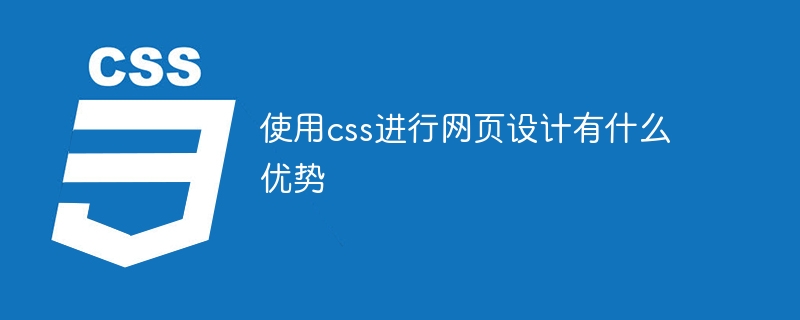What are the advantages of using css for web design?
In web design, the advantages of CSS include: separating content and presentation, simplifying appearance modifications. Enhance accessibility and meet user needs. Ensure consistency and maintainability, simplifying maintenance. Improve performance and reduce HTML code size. Supports responsive design to adapt to different device screen sizes. Provides rich styling options to create visual effects. Simplify team collaboration and increase efficiency.

Advantages of CSS in web design
Using CSS (Cascading Style Sheets) for web design has the following advantages :
1. Separating content and presentation
CSS allows the separation of content (HTML) from presentation (style). This makes it easy to change the look of your website without having to change the content. For example, when you change fonts, colors, or layout, there's no need to edit the HTML code, just update the CSS file.
2. Enhancing Accessibility
CSS makes it easy for users to adjust the appearance of a website to meet their accessibility needs. For example, users can enlarge text size, adjust contrast, or change color schemes.
3. Consistency and Maintainability
CSS helps ensure consistency throughout your website. By defining styles in a central CSS file, you can maintain the same style across all pages, simplifying design and maintenance.
4. Performance Improvements
CSS can improve website performance by reducing the amount of HTML code required. This reduces page load times and provides a better user experience.
5. Responsive Design
CSS allows the creation of responsive websites that adapt to the screens of different devices (e.g. desktop, tablet, smartphone) size. By using media queries, styles can be automatically adjusted based on the device's resolution.
6. Visual Effects
CSS provides a wealth of styling options that enable designers to create impressive visual effects. This includes shadows, gradients, animations and complex layouts.
7. Simplify team collaboration
CSS makes it easy for designers and developers to collaborate. Designers can focus on style, while developers can focus on content and functionality, increasing efficiency.
The above is the detailed content of What are the advantages of using css for web design?. For more information, please follow other related articles on the PHP Chinese website!

Hot AI Tools

Undresser.AI Undress
AI-powered app for creating realistic nude photos

AI Clothes Remover
Online AI tool for removing clothes from photos.

Undress AI Tool
Undress images for free

Clothoff.io
AI clothes remover

Video Face Swap
Swap faces in any video effortlessly with our completely free AI face swap tool!

Hot Article

Hot Tools

Notepad++7.3.1
Easy-to-use and free code editor

SublimeText3 Chinese version
Chinese version, very easy to use

Zend Studio 13.0.1
Powerful PHP integrated development environment

Dreamweaver CS6
Visual web development tools

SublimeText3 Mac version
God-level code editing software (SublimeText3)

Hot Topics
 1393
1393
 52
52
 1207
1207
 24
24
 How to use bootstrap in vue
Apr 07, 2025 pm 11:33 PM
How to use bootstrap in vue
Apr 07, 2025 pm 11:33 PM
Using Bootstrap in Vue.js is divided into five steps: Install Bootstrap. Import Bootstrap in main.js. Use the Bootstrap component directly in the template. Optional: Custom style. Optional: Use plug-ins.
 The Roles of HTML, CSS, and JavaScript: Core Responsibilities
Apr 08, 2025 pm 07:05 PM
The Roles of HTML, CSS, and JavaScript: Core Responsibilities
Apr 08, 2025 pm 07:05 PM
HTML defines the web structure, CSS is responsible for style and layout, and JavaScript gives dynamic interaction. The three perform their duties in web development and jointly build a colorful website.
 How to write split lines on bootstrap
Apr 07, 2025 pm 03:12 PM
How to write split lines on bootstrap
Apr 07, 2025 pm 03:12 PM
There are two ways to create a Bootstrap split line: using the tag, which creates a horizontal split line. Use the CSS border property to create custom style split lines.
 Understanding HTML, CSS, and JavaScript: A Beginner's Guide
Apr 12, 2025 am 12:02 AM
Understanding HTML, CSS, and JavaScript: A Beginner's Guide
Apr 12, 2025 am 12:02 AM
WebdevelopmentreliesonHTML,CSS,andJavaScript:1)HTMLstructurescontent,2)CSSstylesit,and3)JavaScriptaddsinteractivity,formingthebasisofmodernwebexperiences.
 How to set up the framework for bootstrap
Apr 07, 2025 pm 03:27 PM
How to set up the framework for bootstrap
Apr 07, 2025 pm 03:27 PM
To set up the Bootstrap framework, you need to follow these steps: 1. Reference the Bootstrap file via CDN; 2. Download and host the file on your own server; 3. Include the Bootstrap file in HTML; 4. Compile Sass/Less as needed; 5. Import a custom file (optional). Once setup is complete, you can use Bootstrap's grid systems, components, and styles to create responsive websites and applications.
 How to insert pictures on bootstrap
Apr 07, 2025 pm 03:30 PM
How to insert pictures on bootstrap
Apr 07, 2025 pm 03:30 PM
There are several ways to insert images in Bootstrap: insert images directly, using the HTML img tag. With the Bootstrap image component, you can provide responsive images and more styles. Set the image size, use the img-fluid class to make the image adaptable. Set the border, using the img-bordered class. Set the rounded corners and use the img-rounded class. Set the shadow, use the shadow class. Resize and position the image, using CSS style. Using the background image, use the background-image CSS property.
 How to use bootstrap button
Apr 07, 2025 pm 03:09 PM
How to use bootstrap button
Apr 07, 2025 pm 03:09 PM
How to use the Bootstrap button? Introduce Bootstrap CSS to create button elements and add Bootstrap button class to add button text
 How to resize bootstrap
Apr 07, 2025 pm 03:18 PM
How to resize bootstrap
Apr 07, 2025 pm 03:18 PM
To adjust the size of elements in Bootstrap, you can use the dimension class, which includes: adjusting width: .col-, .w-, .mw-adjust height: .h-, .min-h-, .max-h-




